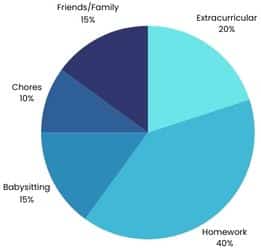Purpose
This activity helps you visualize how you allocate your time and energy across different areas of your life. By understanding your “life pie”, you can make more informed decisions about where to invest your resources to create a balanced and fulfilling life after high school.
Materials Needed
- A blank sheet of paper
- Colored pencils or markers
- A ruler or a compass for drawing circles
- An eraser (just in case)
Instructions
- Draw the Pie Chart
Using a ruler or a compass, draw a large circle in the center of your paper.Divide the circle into slices that represent different areas of your life. These might include Family, Friends, School, Hobbies, Culture/Community, Self-Care, and Future Goals.
- Label Each Slice
Assign a label to each slice of the pie. Think about the roles you play, the communities you are a part of, and the aspects of life that matter most to you. - Size Each Slice
Consider how much time and energy you currently spend in each area. Size each slice according to its significance in your daily life. A larger slice means more of your time/energy is spent there. - Color Coding
Use different colors to fill in each slice. You may choose colors that resonate with you emotionally for each area. For instance, blue for relaxation in Self-Care or green for growth in Future Goals. - Reflect on Your Chart
Once your chart is filled in, reflect on the following questions:
– Does any area seem too large or too small?
– Are there parts of your life you’d like to give more attention to?
– How do the sizes of the slices make you feel about your current life balance? - Write Down Insights
On the back of the paper or in a journal, write down your thoughts about what you see in your life pie chart. Explain why each area is important to you. How does each area contribute to your sense of identity, community, and well-being? - Set Goals
Based on your reflection, set goals for areas you’d like to adjust. This could mean dedicating more time to hobbies that reflect your culture or carving out more space for self-care. - Action Plan
Create a small action plan for how you might begin to rebalance your pie to better reflect your desired life experience. Set specific, achievable steps for yourself. - Review Regularly
Revisit your life pie chart regularly, such as once every month or at the start of each school term, to see if your life balance is shifting in the way you want it to.
Remember your life pie chart is a personal reflection tool. It’s about your unique experience and journey, so be honest and kind to yourself throughout the process.
